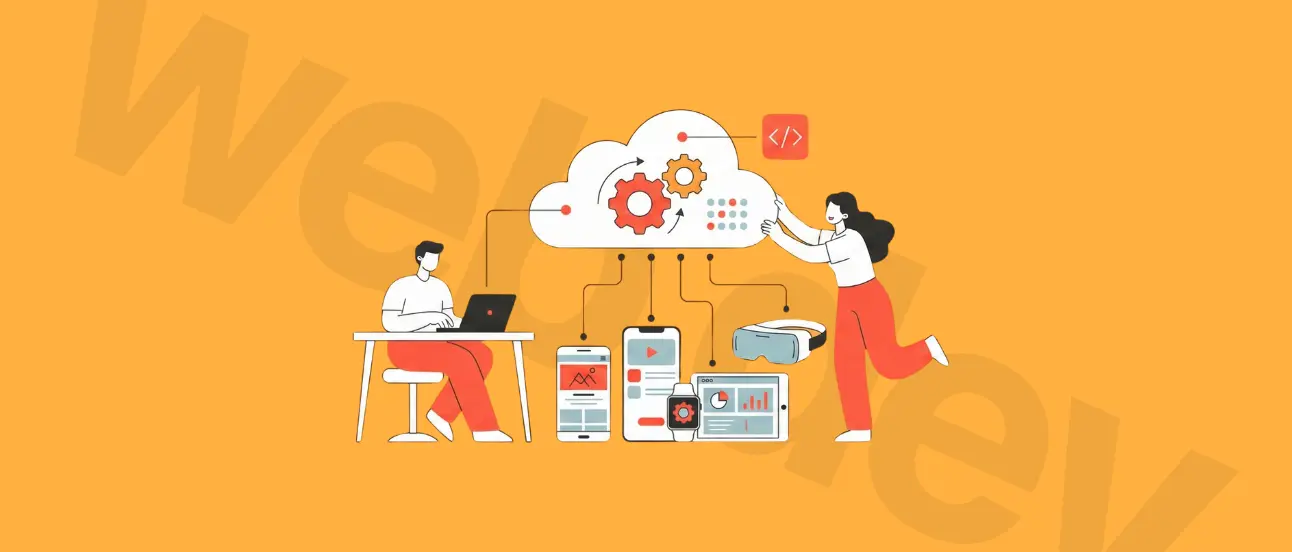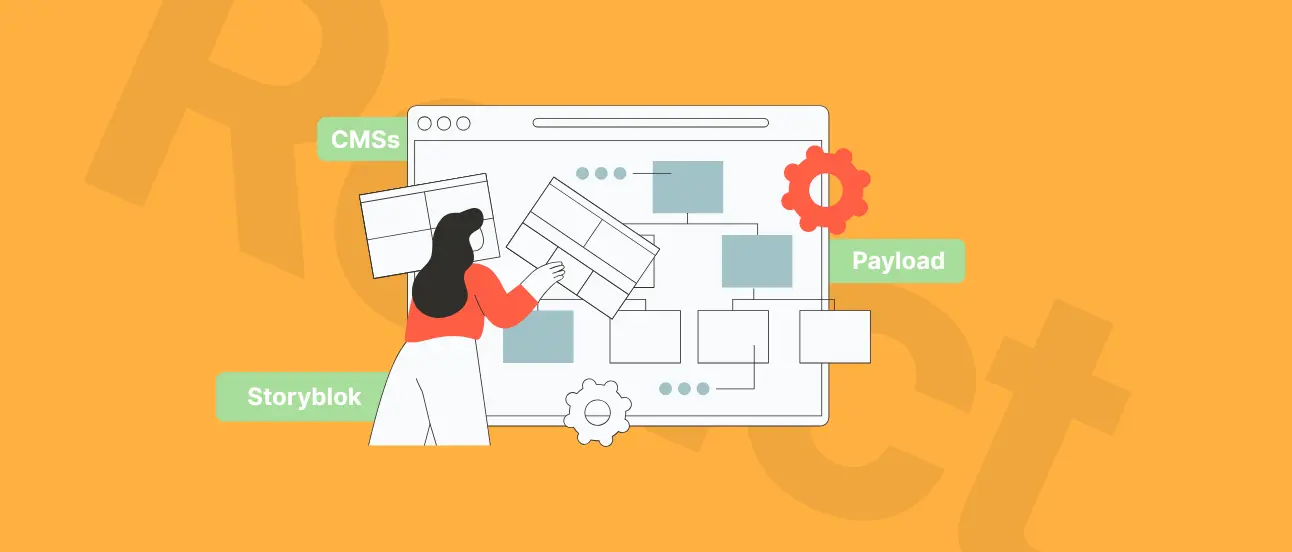429 Error: How to Fix & Avoid It in the Future
If you are a WordPress website owner, you surely struggle with error messages from time to time. Most of these errors are relatively easy to solve, however, there are also WordPress errors that are more complicated. One of them is the 429 error.

Actually, the 429 error... is not an error itself – it’s an HTTP code that communicates a client-side error when someone repeatedly accesses a WordPress website and exceeds the rate limit.
You’ve probably come across dozens of articles about how to fix the error. This article is also meant to give you a few popular ways to do this, however we’ll try to do something even of greater importance for you: to provide you with the bigger picture.
Is WordPress really the only solution you should consider? Why would you be constantly tackling WordPress problems when there are better solutions out there?
Trying headless CMS may be your way to go, as they are an example of content infrastructure that make the 429 error less likely to occur in the long term.
In the article, we’ll:
Explain what the error is and why it occurs.
Dive deeper into how to fix the error.
Share the best solution to avoid the error in the future.
Show you why a headless CMS is better than WordPress.
HTTP Error 429 – When Does the Problem Occur and Why?
First, let’s explain more about what the 'too many requests error' is. Technically, it’s not an error but one of the many HTTP status codes; a response that is sent from either a web server or API (an Application Programming Interface) that occurs when a client has sent too many requests to the server within a certain period.
What Is a 429 Error? Is It an Error Itself?
Technically, the 429 too many requests error is not an error, but one of the many HTTP status codes: a response that is sent from either a web sever or API (an Application Programming Interface) that occurs when a client has sent too many requests to the server within a certain period.
What Does 429 Too Many Requests Mean?
Simply speaking, when you see a 'too many requests' error it means that the server is telling you: Please stop sending requests – the limit of the server has been exceeded and there isn’t enough memory to process another request. The response is meant to be used in conjunction with rate-limiting techniques. This HTTP error can also appear as a response to security measures (it may indicate DDoS attacks or brute force efforts). In such cases, 429 too many requests will block the suspicious IP address to protect the website.
The issue may go away on its own, yet you should nonetheless be proactive in addressing such errors. Otherwise, it impacts your login page and makes it impossible to access. We’ll explain the techniques on how to fix WordPress errors a bit later. Now let’s see what are the reasons for the 429 error.
429 Response Code – What Causes The 429 Error?
An error mainly associated with WordPress plugins – too many requests – tells the client application to stop sending requests because they don’t have enough resources to accept them at this time.
For example, it occurs when a client is trying to access a page on the website too frequently within a short period. This is called rate limiting and it’s used to manage incoming and outgoing traffic to or from a network. For example, if you are using an API that is configured to let 100 API requests per minute, an error will appear when the number of requests exceeds 100 per minute.
Other Reasons For Too Many Requests Error
The 429 response is also a protective measure against users who (either accidentally or intentionally) abuse server resources. The error protects against a backup or overflow of requests that could strain the server. It controls the number and timing of requests to prevent problems before they even arise – the rate limit kicks in when the website is using too many resources on a shared hosting server or service.
Finally, the 429 too many requests may occur in the case of a brute-force login attempt when a hacker keeps trying to log into your website. Implementing rate limiting allows for an improved flow of data and a security boost by blocking cyberattacks such as DDoS.
How To Fix Error 429 Too Many Requests? Best WordPress Solutions
Of course, you can always wait to send another request. However, there are a number of common solutions for WordPress optimization. Thus, you may consider starting with the following.

First Step – Finding Out Which WordPress Plugin is Causing the CMS Error 429
You can disable all WordPress plugins as some of them may conflict which usually causes a malfunction. After you disable the plugins, try examining your website – if it’s back to normal, this means a faulty plugin was causing the HTTP error. Then, you should activate the plugins one by one to detect the one causing the requests error. Once you have found it, try updating it and see if the problem is solved.
Changing the WordPress Theme
The best option is to switch to a default one. If a plugin isn’t causing the bug, it may be an issue with your active theme. Try manually disabling it and switching to one of the default ones. If the theme is a reason for the many requests error, it should be gone after it’s disabled. Alternatively, you can delete the theme and reinstall it.
Implementing Exponential Backoff
When you use this approach, your device won’t immediately repeat a failed request. Instead, it will perform a series of retries with progressively longer waiting times between attempts. The request will be ultimately accepted, and you will know what time or rate is acceptable. If you want to implement the approach, you can just add code.
Setting Your Own Throttling Limit
Especially if you use a costly API and you don’t want to exceed your usage policy. Throttling means limiting the number of requests an user can submit in a predefined amount of time. If a user exceeds the limit, the server (or API) will be dropped or fulfilled with cached data. This approach is recommended for platforms that need to prevent client apps from exceeding their limits.
Contacting the Hosting Provider
Most website owners often consider contacting the hosting provider as a last resort. However, reaching out to the hosting provider may help you solve the issue or at least get valuable insight .The cause of HTTP status codes may originate from the server and not your website, after all. It may be your host who blocks requests from specific third-party platforms. These can include crawlers, search engines, and other applications, such as Google Search Console, that make large numbers of requests to your site.

429 Error And Many More – What About Other WordPress Errors?
The too many requests is only one of the typical, frequently occurring WordPress errors. Below you will find some information about errors that every WordPress website owner comes across from time to time.
Internal Server Error
Probably one of the most frustrating issues, that is often unclear about the underlying problem. It says:
The server contacted an internal error or misconfiguration and was unable to complete your request.
The error appears when there is a problem with your website’s .htaccess file or when your website has reached its memory limit. To verify whether the file is causing the error, you should disable it.
Parse Error / Syntax Error
It occurs when there is an issue with the website’s code, usually in the functions.php file. The page isn’t loaded, and the message explains what the issue is and where it occurred. Parse error / syntax error can come up e.g. when you’re adding snippets of code into your WordPress files because you have missed a character or two when copying it, or because of the wrong syntax.
To fix the error, you need access to the specified file using SFTP. A good thing is that the parse error message tells you exactly on what line the issue exists. Additionally, you’ll be provided with information about an exact cause of the error’s emergence. This may include:
Syntax error, unexpected variable
Syntax error, unexpected end of file
Syntax error, unexpected identifier
Syntax error, unexpected token
All you need to do is find that line and fix the problem.
WSoD (White Screen of Death)
WSoD (White Screen of Death) is one of the most infamous WordPress errors. It replaces the entire site with a blank white wall, leaving no error message or further assistance. The issue can come up for a variety of reasons. There are many ways to fix it, though. Among others, you can try disabling the plugins, disabling the theme, activating the WordPress debug mode, raising the memory limit, or purging the cache. If none of these helps, you should contact your hosting provider’s support team.
404 Error
This error shows the ‘Oops! That page can’t be found’ message. For sure, it’s familiar to most Internet users all over the world. A 404 error occurs when the server hasn’t been able to find the requested page. It is often caused by broken links or changed URLs.
If you’re certain that the page should be available, the error can be also caused by the .htaccess file – URLs can be redirected incorrectly. Also, the .htaccess file could have been accidentally removed. To fix the issue, you should fix your WordPress permalink settings to rewrite rules for your website and update the permalink settings. If it doesn’t help, update the .htaccess file.
Other common WordPress errors include Error Establishing a Database Connection, Connection Timed Out Error or You’re Unable to Access the Admin Area.
There is no magic solution to WordPress errors but… you can just switch to a headless CMS and Jamstack! As opposed to problematic monolithic CMS (traditional CMS), it’s a new way of building and managing websites.
Problem With Too Many Requests Error And Others – Why Headless CMS / Jamstack May Be a Better Solution?
What is Jamstack? Simply speaking, Jamstack is a way to improve performance, increase scalability and obtain better security, based on pre-rendered static websites. It’s a modern web development architecture that makes it possible to improve website performance by rendering out a set of static pages with dynamic elements at build time and deploying them to a CDN (Content Delivery Network).
See how we deliver web development solutions that empower you to grow
Learn more
As the website is (mostly) just static files on the CDN, the scalability is unlimited. Since the servers that process the content are not exposed to the public Internet, security vulnerabilities are reduced to the minimum.
Jamstack is also based on two core principles: prerendering and decoupling. With Jamstack, the prerendering of highly optimized static pages and assets reduces the e-commerce website development cost, complexity, and risk of dynamic servers as critical infrastructure. Site performance is improved and it’s easier to scale.
On the other hand, decoupling is a process of creating a clean separation between systems. It makes services easy to swap in and out, and it’s easier to use third parties instead of homegrown web apps for all website functionalities.
Decoupling means you can use one of 100 future-proof and user-friendly headless CMS for managing the content on your website.
The frontend and backend are completely separate systems (as opposed to traditional architecture). Instead of having your content coupled to a particular output, a headless CMS provides your content as data over an API.
Why Doesn’t a Headless CMS Have So Many Problems with 429 Errors?
There are many benefits of using a headless CMS + Jamstack development services over WordPress.
You Can Avoid Many WordPress Errors
This is because Headless Content Management Systems ensure that 429 errors occur less frequently. The only situation where the error can appear is when incorrect API requests are made.
In WordPress, it takes so much time to find the reason for a too many requests error and the process of fixing it is nothing but strenuous. As explained above, in some cases, you’re forced to deactivate and reactivate plugins, themes, etc. In Jamstack, on the other hand, you know you should take a look at API requests.
The Security Level is Much Higher
The surface area for potential attacks is minimized thanks to server-side processes that are abstracted into microservice APIs. Hackers can’t access as much from any single-entry point. Headless CMS-based websites are more resistant to DDoS attacks because Jamstack doesn’t store the data on the server but in CDN (Content Delivery Networks), which makes breaching impossible.
When it comes to the benefits of Jamstack, security is one the most important, as DDoS attacks both cause economic losses and affect the reputation and image of the website – an attacked website may be added to Google’s blacklist of websites flagged as unsafe for users. With Jamstack, you’re safer.
Jamstack doesn't store the data on the server but in CDN (Content Delivery Networks), which makes breaching almost impossible. When it comes to the benefits of Jamstack, security is on the most important, as DDoS attacks both cause economic losses and affect the reputation and image of the website- an attacked website may me added to Google's blacklist of websites flagged as unsafe for users. With Jamstack you're safer.
Content Editing and Development Workflows Are Much Better
Simply speaking, the Jamstack approach decouples the frontend from the backend, which helps teams decouple their workflows.
Performance Increases
Best Jamstack websites are extremely performant. They are generated at a deploy time, so you don’t have to wait for pages to be built while the request is being sent. Page loads are faster because you don’t have to wait for server responses every time you load a page – they are already built.
Development and Content Creation Teams Have Greater Autonomy Because of Decoupling
Also, the growing Jamstack CMS popularity suggests that the modern ecosystem lends itself to the best developer experience. Frontends can be changed at any time without impacting the CMS. And content teams have faster editing experiences. They can easily and quickly manage and deliver content and its associated infrastructure for more channels.
It’s Cheap
There’s no need to pay for expensive caching services. Also, such a solution is easier to scale, as all assets are available as static files and available over CDN.
As you can see, it’s really difficult to turn a blind eye to the benefits of Jamstack and headless commerce. From more security and easier scalability to faster performance – they have got you covered.
Dajemy Słowo wanted to establish the agency’s position in a new digital era: enthusiastic, highly performant, and incredibly user-friendly. We joined them on their mission!
5/5
Clutch review
0.5 s
FCP
0
Attacks

Conclusion – Why Should You Choose Jamstack & Headless CMS Solutions to Avoid Problems Like 429 Errors?
As above, there are many WordPress errors you may struggle with as a website owner. Knowing how to fix them can save your business. In the article, you have found some recommended solutions on how to fix the 429 too many requests error.
As you can see, we also suggest that to avoid similar issues in the future, you should consider switching to Jamstack and a headless CMS. It’s much better and more efficient than fixing errors in WordPress plugins every now and when.
If you need a professional consultancy in the area of Jamstack, drop us a line! We're an eCommerce & web development services company with over 10 years of experience so we'll easily analyze your business needs.
Let’s Create a Great Website Together
We'll shape your web platform the way you win it!
More posts in this category

December 09, 2025 • 12 min read
READ MOREWhat is Headless Architecture? Benefits, Risks, and When It Makes Sense
If you’re hearing “headless” in every technology conversation and quietly thinking “Is this actually for us, or just another buzzword?,” this article is for you.

December 02, 2025 • 8 min read
READ MORESvelte in 2026: Why It’s (Still) a Big Deal - Svelte 5 Features, SvelteKit, Pros & Cons
Svelte 5 and SvelteKit offer a faster, simpler approach to building modern frontends. Here is what’s new, how the framework works today, where it fits in real projects, and when alternatives might be a better choice.

November 26, 2025 • 10 min read
READ MOREBest Headless CMS for React (2026): 15 Top Picks + When to Use Each
React works well with a headless CMS because it speeds up development, improves performance, and keeps content operations simple. You will see how platforms like Storyblok, Sanity, Hygraph, Prismic, Strapi, Payload, and Contentful integrate with React and Next.js, and what makes each one a better fit for different team sizes and needs.
